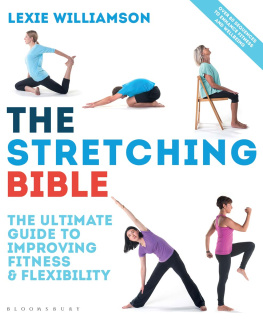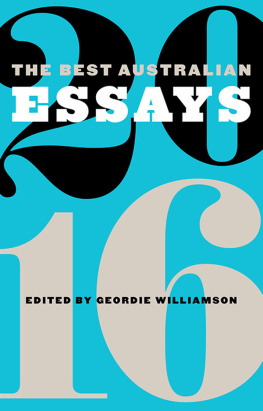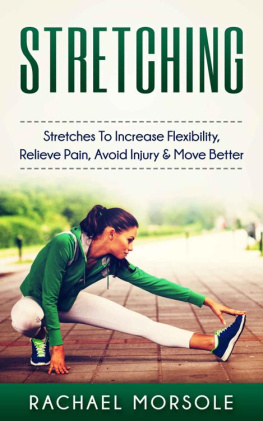

Bloomsbury Sport
An imprint of Bloomsbury Publishing Plc
| 50 Bedford Square | 1385 Broadway |
| London | New York |
| WC1B 3DP | NY 10018 |
| UK | USA |
www.bloomsbury.com
BLOOMSBURY and the Diana logo are trademarks of Bloomsbury Publishing Plc
This electronic edition published in 2017 by Bloomsbury Publishing Plc
First published in 2017
Lexie Williamson, 2017
Photos by Grant Pritchard Photography
Photos on Stretches By Sport opening page Getty Images
Lexie Williamson has asserted her right under the Copyright, Designs and Patents Act, 1988, to be identified as the Authors of this work.
All rights reserved
You may not copy, distribute, transmit, reproduce or otherwise make available this publication (or any part of it) in any form, or by any means (including without limitation electronic, digital, optical, mechanical, photocopying, printing, recording or otherwise), without the prior written permission of the publisher. Any person who does any unauthorised act in relation to this publication may be liable to criminal prosecution and civil claims for damages.
No responsibility for loss caused to any individual or organization acting on or refraining from action as a result of the material in this publication can be accepted by Bloomsbury or the author.
A catalogue record for this book is available from the British Library.
ISBN: 978-1-4729-2987-7 (PB)
ISBN: 978-1-4729-2988-4 (eBook)
ISBN: 978-1-4729-2989-1 (ePDF)
To find out more about our authors and their books please visit www.bloomsbury.com where you will find extracts, author interviews and details of forthcoming events, and to be the first to hear about latest releases and special offers, sign up for our newsletters.
CONTENTS
Each section features individual stretches plus four sequences
Eight-step targeted routines for all ages and flexibility levels
Twenty sports each with six warm-up and ten cool down stretches
Introduction

There are 101 Reasons to Stretch
To sit straighter, stand taller, move more freely, sidestep injury, release stress, feel younger, improve your golf swing and sleep better.
The Stretching Bible is a one-stop resource that packages stretches and ready-made sequences in a way that is easy and accessible whatever your reasons for wanting to be more supple or mobile. It offers sequences for different ages, (children, teenagers and seniors), occupations (commuters, desk workers and manual workers), time constraints (five minute routines), and level (gentle, intermediate and advanced).
Stretching techniques are also divided into anatomical sections, such as for your back and sides or your upper legs, in order to hone in on exercises for an aching lower back, tight hamstrings or stiff shoulders. And the final section features highly targeted warm-up and cool down stretching routines for 20 sports from American football through to weight training.
In the last few years of bringing sport-specific yoga to athletes as a Yoga Sports Coach, Ive witnessed a tenfold increase in interest within the sports community in what we call flexibility training. The emphasis for athletes is not on replicating pretzel positions (although advanced stretches are here for those wishing to go deeper), but on simple, functional techniques to improve performance and reduce post-exercise muscle soreness.
Of course, the global rise in popularity of yoga and Pilates demonstrates that many people also want to stretch simply because it feels good. Some have sedentary desk jobs and need to move and release muscular tension. Others are seeking a little mental and physical space in a stressful world. Regardless of age, occupation, situation and perceived flexibility levels there are a range of stretches to suit everyone, so flick through, experiment and enjoy.
Why Stretch?
To counter the desk job
Many of us now spend eight, nine or ten hours a day at our desks. Add in time spent commuting and these long periods of sitting can negatively impact the body. Possibly the biggest side effect of prolonged sitting is lower back pain and discomfort. Simple stretches will maintain comfort levels throughout the day and lessen the effect of sedentary work. Many are so simple and subtle that co-workers wont even notice that you are stretching. See .
To maintain mobility in old age
Our range of motion can (but doesnt have to) lessen gradually over the years, and these physiological changes, combined with a reduction in activity, result in stiffer joints, but a good level of flexibility can be maintained with a regular stretching routine. Many of my best yoga students are older ladies who outshine me on the mat with their strong, supple bodies: the product of a lifetime of stretching. Having said that, its never too late to start stretching. The emphasis is not on touching toes or forcing the body into gymnastic shapes but on gentle, limbering movements to improve blood flow, increase energy and help facilitate everyday movements.
See .
To avoid injury
Ten-minute stretches post-run or bike ride, or after non-athletic endeavours such as clearing snow or mowing the lawn, will greatly reduce the chance of injury. This is stretching as pre-habilitation or pre-hab rather than rehab (for which a physiotherapist should be your first port of call). Sportspeople know they ought to stretch, but are sometimes unsure what stretches to try for their sport or become stuck in a rut repeating a routine that is not sport-specific. Aside from helping sportspeople avoid injury, stretching can vastly reduce the chances of suffering with DOMS (Delayed Onset Muscle Soreness) or that inability to bend your knees to descend the stairs 24 to 48 hours after a squat-heavy gym session.
See .
To improve posture
Modern life demands that we sit a lot while driving, commuting, working at a desk or relaxing on the sofa, and the temptation to slouch is ever-present. Gravity and time also play a part in poor posture. But a few simple stretches, combined with a little back strengthening, can remedy this and result in a healthier, more upright stance that feels good and conveys confidence. Many are simple movements, such as drawing back the shoulders and squeezing the shoulder blades closer, but will gradually instill an everyday awareness of how we are sitting or standing. Stretching can make a huge difference to posture, especially when combined with back-strengthening exercises such as the Cobra on .
See .
To relieve stress
Stress is essentially a mental phenomenon and usually the result of a perceived inability to cope with lifes demands, but the effects are partly physical: gritted teeth, a churning stomach and muscles that feel locked particularly around the shoulders. Stretching unlocks this muscular tightness. Gentle movements, such as head rolls or relaxing stretches, calm the mind. This soothing effect is doubled when stretching is combined with deep breathing. Many people in the West now flock to yoga as it releases stress through a system of physical stretching and breathing. Novice yoga students sometimes proceed to mental control through meditation techniques, but the majority just enjoy the simple pleasure of lying on a mat, reaching their arms overhead and other physical stretches.
Next page













